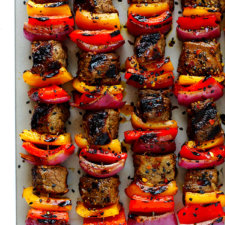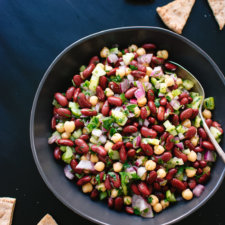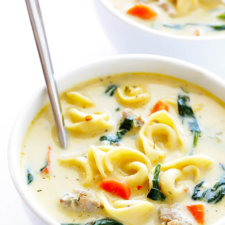Bring a taste of Korea to your backyard barbecue with these delectable Korean Steak Kabobs. Tender pieces of flank steak are marinated in a savory and sweet sauce, then skewered with veggies and grilled to perfection for a dish that's equal parts flavorful and satisfying.

Flank steak, the main ingredient of this recipe, is a lean cut of beef that's packed with flavor and perfect for grilling. It's typically easy to find in supermarkets, but be aware that it can also be labelled as London broil. Rice wine vinegar, another essential ingredient, is a type of vinegar made from fermented rice. It's a staple in Asian cooking and can be found in the international aisle of most grocery stores. If you can't find it, you can substitute it with white wine vinegar or apple cider vinegar.
Ingredients for Your Korean Steak Kabobs
Flank steak: A flavorful, lean cut of beef that's perfect for grilling.
Bell peppers: Add a pop of color and a sweet, mild flavor to the kabobs.
Red onion: Brings a sharp, slightly sweet flavor that complements the other ingredients.
Salt: Enhances the flavors of the dish.
Black pepper: Adds a hint of heat.
Toasted sesame seeds: Gives a pleasant crunch and nutty flavor.
Soy sauce: Adds savory depth to the marinade.
Rice wine vinegar: Adds tanginess to the marinade.
Honey: Balances the savory flavors with a touch of sweetness.
Toasted sesame oil: Infuses the dish with a rich, nutty flavor.
Garlic: Its pungent flavor is a perfect match for the robust marinade.
One reader, Abram Scoggins says:





This Korean steak kabobs recipe is a game-changer! The marinade is bursting with flavor, and the steak turns out incredibly tender. The combination of peppers and onions adds a delightful crunch. Plus, the dipping sauce is the perfect finishing touch. A must-try for any BBQ enthusiast!
Techniques Required for Making Korean Steak Kabobs
How to prepare the marinade: Whisk together the soy sauce, rice wine vinegar, honey, toasted sesame oil, and minced garlic until well combined. Set aside half of the marinade for dipping and use the other half for marinating the steak.
How to marinate the steak: Combine the flank steak with half of the marinade in a large ziplock bag or bowl. Toss until the steak is evenly coated, then seal or cover and refrigerate for at least 30 minutes, or up to 8 hours.
How to grill the kabobs: Preheat the grill to medium-high heat. Thread the marinated steak, bell peppers, and red onion alternately onto skewers. Brush the skewers with the remaining marinade and season with salt and pepper. Grill for 2 to 3 minutes per side, turning once, until the steak reaches the desired level of doneness.
How to rest the kabobs: After grilling, remove the skewers from the grill and let them rest for 5 minutes. Brush the kabobs evenly with the reserved marinade before serving.
How to serve: Sprinkle the grilled steak kabobs with toasted sesame seeds before serving. Enjoy with the reserved marinade as a dipping sauce.
How To Make Korean Steak Kabobs
A delicious Korean-inspired dish that’ll surely be a hit on your next barbecue party! These steak kabobs are incredibly tender and juicy packed with flavors.
Serves:
Ingredients
- 2lbsflank steak(or sirloin) cut into bite-sized pieces
- 3bell pepperslarge, cored and cut into bite-sized pieces
- 1red onionlarge, peeled and sliced into bite-sized pieces
- salt
- black pepperfreshly cracked
- toasted sesame seeds
For Sauce/Marinade:
- ½cupsoy sauce
- ¼cuprice wine vinegar
- 3tbsphoney
- 1tbsptoasted sesame oil
- 4clovesgarlicpeeled and minced (or pressed)
Equipments
-
Metal or Wooden Skewers
Instructions
-
Whisk all the sauce ingredients together until combined. Set aside half of the sauce to be used as a dipping sauce, and half to be used as a marinade.
-
Combine the steak with (half of) the sauce in a large ziplock bag or bowl, and toss until the steak is evenly coated.
-
Seal or cover, then refrigerate for at least 30 minutes, or up to 8 hours.
-
Once you’re ready to cook the skewers, heat grill to medium-high heat.
-
Thread the skewers alternately with the marinated steak, peppers and onions.
-
Brush each skewer liberally with the remaining marinade, and season each with a pinch of salt and pepper.
-
Grill the skewers for 2 to 3 minutes per side, turning once, or until the steak is cooked to your desired level of doneness.
-
Remove skewers from grill and let rest for 5 minutes.
-
Brush each kabob evenly with the remaining sauce (the half that was not used for the marinade).
Nutrition
- Calories: 514.75kcal
- Fat: 16.54g
- Saturated Fat: 5.77g
- Monounsaturated Fat: 6.26g
- Polyunsaturated Fat: 2.19g
- Carbohydrates: 28.93g
- Fiber: 4.27g
- Sugar: 13.15g
- Protein: 54.05g
- Cholesterol: 102.81mg
- Sodium: 14097.97mg
- Calcium: 162.29mg
- Potassium: 1811.88mg
- Iron: 6.71mg
- Vitamin A: 94.01µg
- Vitamin C: 78.20mg
Technique Tip for Perfecting Korean Steak Kabobs
When marinating the flank steak, ensure that all pieces are fully submerged in the marinade for optimal flavor infusion. If you notice some pieces are not fully coated, feel free to stir or flip the pieces halfway through the marinating process. This will ensure that the soy sauce, rice wine vinegar, honey, sesame oil, and garlic penetrate every bit of the meat, resulting in a more flavorful and juicy steak kabob.
Time-Saving Tips for Preparing Korean Steak Kabobs
Prep ahead: Marinate the steak and chop the vegetables the night before to save time on the day of cooking.
Use pre-cut veggies: Save time by using pre-cut bell peppers and onions from the grocery store.
Grill in batches: If you have a large batch, grill the skewers in batches to ensure even cooking and prevent overcrowding on the grill.
Invest in a good grill: A high-quality grill with even heat distribution can save time and ensure consistent cooking results.
Organize your workspace: Arrange all the ingredients and tools in an organized manner to streamline the cooking process.
Prep the skewers in advance: Thread the skewers with the marinated steak and vegetables ahead of time for quick and easy grilling.
Substitute Ingredients For Korean Steak Kabobs Recipe
flank steak - Substitute with skirt steak: Skirt steak is a flavorful and tender cut of beef that works well for grilling and has a similar texture to flank steak.
bell peppers - Substitute with mushrooms: Mushrooms can provide a meaty texture and absorb flavors well when grilled, making them a great substitute for bell peppers.
red onion - Substitute with shallots: Shallots have a milder flavor compared to red onions and caramelize beautifully when grilled, adding a sweet and savory element to the kabobs.
soy sauce - Substitute with tamari: Tamari is a gluten-free alternative to soy sauce with a rich umami flavor, making it a suitable substitute for those with gluten sensitivities.
rice wine vinegar - Substitute with apple cider vinegar: Apple cider vinegar provides a slightly fruity and tangy flavor, similar to rice wine vinegar, and works well in marinades.
honey - Substitute with maple syrup: Maple syrup adds a natural sweetness and depth of flavor similar to honey, making it a great substitute in the marinade for the kabobs.
toasted sesame oil - Substitute with peanut oil: Peanut oil has a nutty flavor and high smoke point, making it a suitable substitute for toasted sesame oil in the marinade.
garlic - Substitute with garlic powder: Garlic powder can be used as a substitute for fresh garlic in marinades, providing a concentrated garlic flavor without the need for mincing or chopping.
Presenting Korean Steak Kabobs: Tips for a Beautiful Dish
Elevate the plating: When presenting the Korean steak kabobs, focus on creating a visually stunning plate. Arrange the kabobs in a deliberate and artistic manner, ensuring that each element is showcased beautifully.
Incorporate vibrant colors: Utilize the colorful bell peppers and red onions to add a pop of color to the plate. The bright hues will not only enhance the visual appeal but also complement the flavors of the dish.
Garnish with toasted sesame seeds: Sprinkle the kabobs with toasted sesame seeds as a finishing touch. This will add a delightful nutty flavor and a touch of elegance to the presentation.
Utilize negative space: Embrace the concept of negative space on the plate to allow the kabobs to stand out. A well-balanced use of space will draw attention to the dish and create a sense of sophistication.
Incorporate symmetry: Arrange the kabobs symmetrically on the plate to create a sense of harmony and balance. This attention to detail will showcase precision and finesse in the presentation.
Consider the plate shape and size: Choose a plate that complements the length of the kabobs and allows for an aesthetically pleasing arrangement. The plate itself should enhance the overall presentation.
Highlight the dipping sauce: Present the reserved dipping sauce in a small, elegant vessel alongside the kabobs. This will add a touch of sophistication and provide a visual cue for the diners to engage with the accompanying flavors.
Emphasize the grill marks: Showcase the beautiful grill marks on the steak to highlight the cooking technique and add a rustic, yet refined, element to the presentation.
Storing and Freezing Korean Steak Kabobs: A Guide
- Let the korean steak kabobs cool completely before storing them in an airtight container or wrap them tightly with plastic wrap or aluminum foil.
- Store the kabobs in the refrigerator for up to 3-4 days.
- To freeze the kabobs, place them in a freezer-safe container or zip-lock bag, removing as much air as possible to prevent freezer burn.
- Label the container or bag with the date and contents for easy identification.
- Freeze the kabobs for up to 2-3 months for optimal quality and flavor.
- When ready to reheat, thaw the kabobs in the refrigerator overnight.
- Reheat the kabobs in the oven, on the grill, or in a skillet over medium heat until they are heated through and the steak reaches your desired level of doneness.
- Be sure to reheat the kabobs to an internal temperature of at least 165°F (74°C) to ensure food safety.
- If you have leftover marinade, discard it and do not reuse it, as it has been in contact with raw meat and may contain harmful bacteria.
- For best results, consume the reheated kabobs immediately and do not refreeze them once they have been thawed.
How To Reheat Leftover Korean Steak Kabobs
Preheat your oven to 350°F (175°C). Place the leftover korean steak kabobs on a baking sheet lined with aluminum foil. Cover the kabobs loosely with another piece of foil to prevent them from drying out. Reheat in the oven for 10-15 minutes, or until the steak and vegetables are heated through.
For a quicker option, you can use the microwave. Place the kabobs on a microwave-safe plate and cover them with a damp paper towel. Microwave on high for 1-2 minutes, or until the kabobs are heated through. Be careful not to overheat them, as this can cause the steak to become tough and rubbery.
If you have a grill or grill pan, you can reheat the kabobs over medium-high heat. Brush the kabobs with a little olive oil or the reserved marinade to keep them moist. Grill for 1-2 minutes per side, or until the kabobs are heated through and have a nice char.
For a stovetop method, heat a skillet or sauté pan over medium-high heat. Add a small amount of oil or butter to the pan. Once hot, add the kabobs and cook for 1-2 minutes per side, or until heated through. Be sure to rotate the kabobs frequently to ensure even heating.
Regardless of the reheating method you choose, be sure not to overcook the steak, as it can quickly become dry and tough. If the vegetables are not heated through by the time the steak is ready, you can remove the steak from the skewers and continue heating the vegetables until they reach your desired temperature.
Interesting Fact About Korean Steak Kabobs
The Korean steak kabobs recipe is a delicious fusion of flavors, combining the savory taste of marinated steak with the sweetness of honey and the tanginess of rice wine vinegar. This dish is a perfect example of the popular Korean barbecue style, which is known for its bold and vibrant flavors. The use of bell peppers and red onions adds a colorful and nutritious element to the dish, making it a well-rounded meal. The toasted sesame seeds provide a delightful nutty flavor and a satisfying crunch. This recipe is a great way to introduce Korean cuisine to your grilling repertoire.
Is Making Korean Steak Kabobs at Home Cost-Effective?
The cost-effectiveness of this Korean steak kabobs recipe is quite high. Flank steak is a relatively affordable cut of meat, and the vegetables used are also budget-friendly. The marinade ingredients are commonly found in most households, making this recipe quite cost-effective. The overall verdict rating for this recipe is 9 out of 10. The approximate cost for a household of 4 people is around $25-$30, making it a reasonable and economical choice for a delicious and satisfying meal.
Are Korean Steak Kabobs Healthy or Unhealthy?
The Korean steak kabobs recipe is a relatively healthy dish with a good balance of protein, vegetables, and flavor. The flank steak provides a lean source of protein, while the bell peppers and onions add fiber, vitamins, and minerals. The marinade, made with soy sauce, rice wine vinegar, honey, sesame oil, and garlic, adds depth to the dish without relying on excessive amounts of unhealthy fats or sugars.
However, there are a few areas where the recipe could be improved to make it even healthier:
- Reduce the amount of soy sauce in the marinade to lower the sodium content. You can replace some of the soy sauce with low-sodium broth or water.
- Use a leaner cut of beef, such as sirloin or tenderloin, to further reduce the fat content.
- Increase the variety of vegetables used in the kabobs. Consider adding mushrooms, zucchini, or cherry tomatoes for added nutrients and fiber.
- Serve the kabobs with a side of brown rice or quinoa instead of white rice to increase the fiber and nutrient content of the meal.
- Limit the amount of honey used in the marinade to reduce the sugar content. You can also experiment with sugar alternatives like stevia or monk fruit sweetener.
Editor's Opinion: Thoughts on Korean Steak Kabobs
This Korean steak kabobs recipe is a delightful fusion of flavors and textures. The marinade's sweet and savory notes complement the tender flank steak, while the vibrant bell peppers and red onions add a satisfying crunch. The grilling process enhances the smoky essence, creating a harmonious balance of tastes. The toasted sesame seeds provide a delightful nuttiness, elevating the dish to a whole new level. This recipe is a perfect choice for a gathering or a casual weeknight meal, showcasing the rich and dynamic flavors of Korean cuisine.
Enhance Your Korean Steak Kabobs Recipe with These Unique Side Dishes:
Similar Recipes to Try: Alternatives to Korean Steak Kabobs
Perfect Pairings: Appetizers and Desserts for Korean Steak Kabobs
Why trust this Korean Steak Kabobs Recipe:
This recipe guarantees a mouthwatering experience with its succulent flank steak, vibrant bell peppers, and aromatic red onion. The savory marinade, featuring soy sauce, rice wine vinegar, and toasted sesame oil, infuses the meat with irresistible flavors. The careful grilling process ensures a perfect char on the steak while preserving its tenderness. With a final touch of toasted sesame seeds, this dish promises to elevate your dining experience. Trust in the quality of the ingredients and the expertise behind this recipe for a delightful Korean steak kabob adventure.
Was this page helpful?
Have your own special recipe to share? Submit Your Recipe Today!














